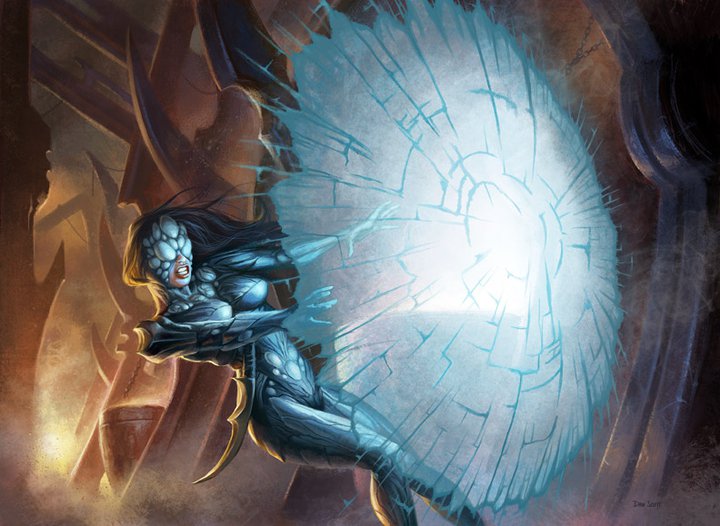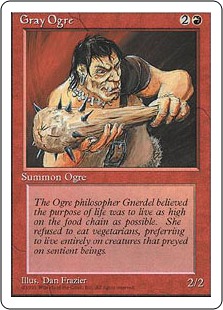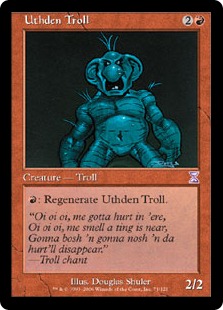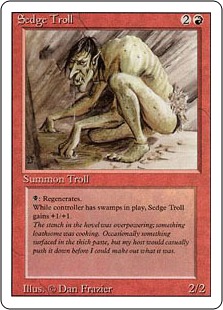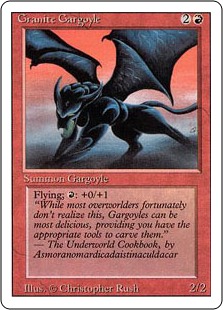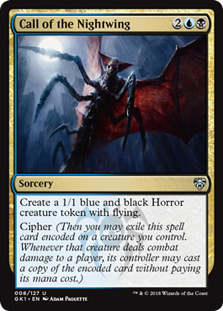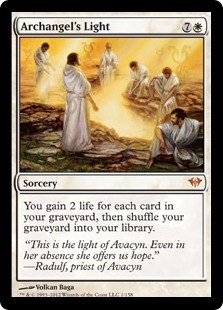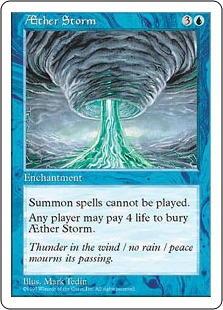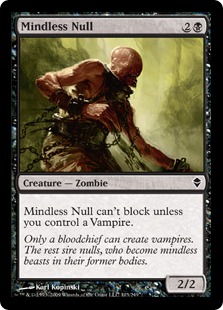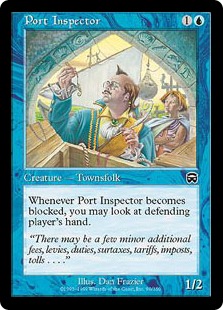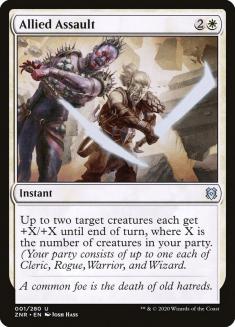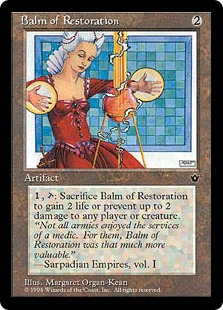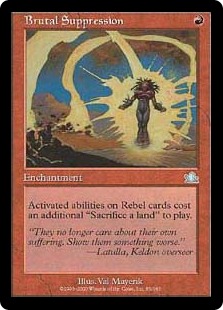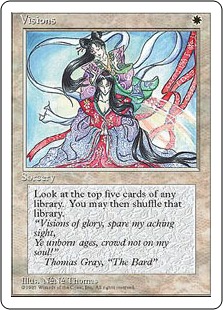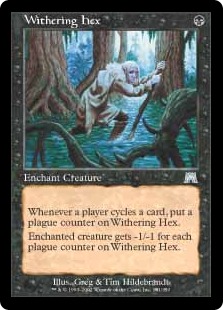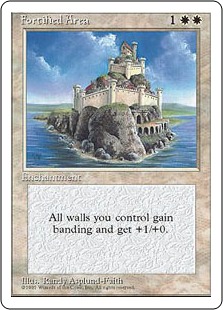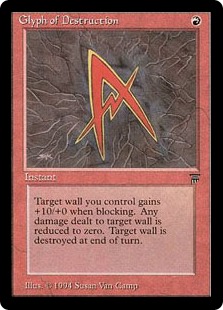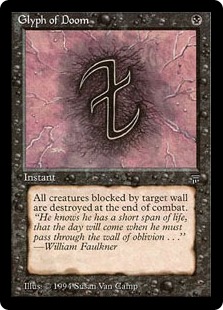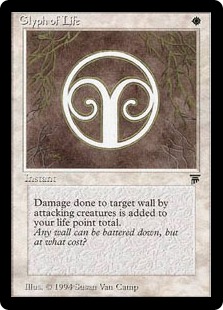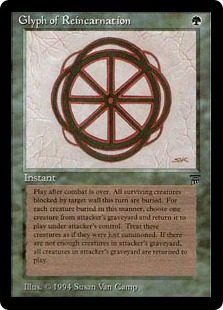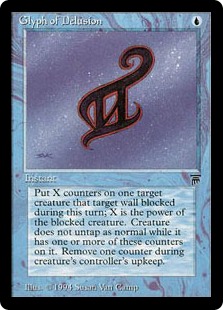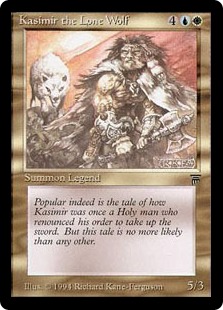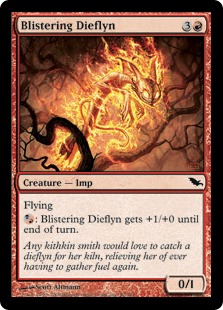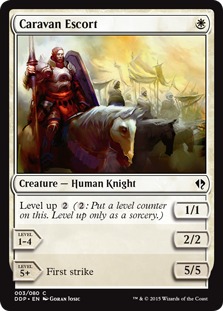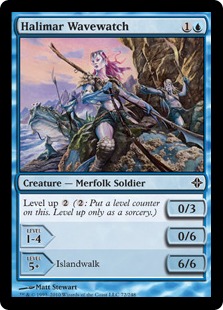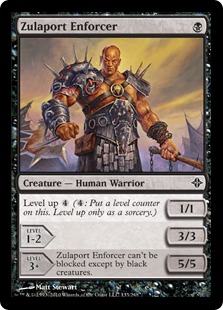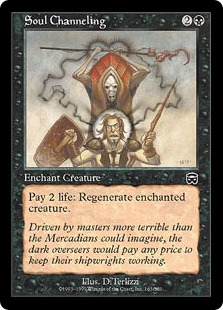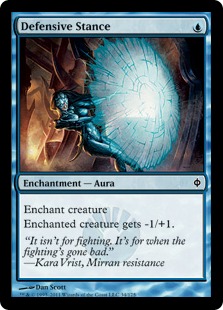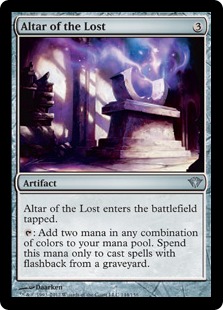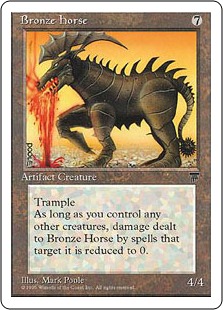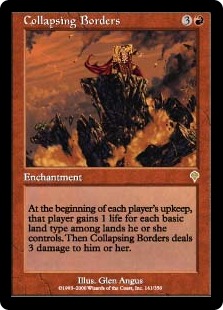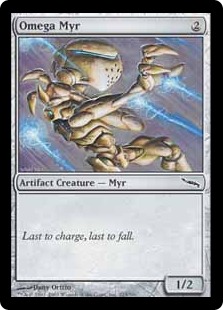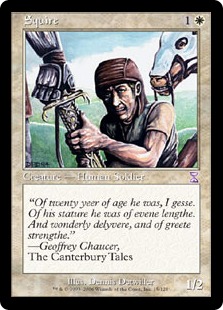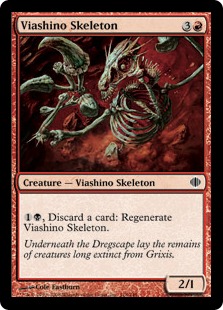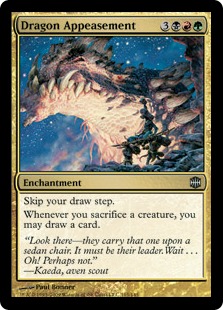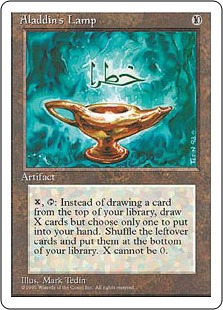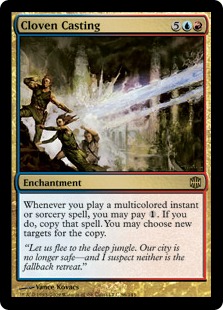There are over 25,000 unique cards in the game of Magic: The Gathering. The vast majority of these have found a home in people’s decks, merrily being played from the comfort of a kitchen table, or at a local game store’s Friday Night Magic event, or maybe even at the tournament hall. Wizards of the Coast (WotC) is in the business of producing game pieces that can be played with, after all! But every now and then, a card slips out the door that is just so bad, so unplayable, that you have you stop and wonder, “Why was this card made?”
In this series of articles, I want to take a look at the bottom-of-the-barrel cards from the history of MTG. These are the lowest 0.4% of all cards in existence in the game of Magic. But before I dive into a look at the 100 worst Magic cards of all time, I want to define what separates a just kind of bad Magic card from one of the truly worst of all time! For the sake of expediency, I’ve grouped together cards that are either part of a cycle or are virtually identical into one slot on the list.
The Gray Ogre Baseline
Let’s look at our friend Gray Ogre.
Gray Ogre was printed in Limited Edition Alpha, when the base stats expected for a three-mana value creature were two power and two toughness. Even then, Gray Ogre was outclassed by not one, not two, but three other creatures from the very start: Uthden Troll, Sedge Troll, and Granite Gargoyle.
All three of these creatures not only had the same base stats as Gray Ogre, they also each had one or more additional abilities that made them outclass Gray Ogre. Uthden Troll could regenerate. Sedge Troll could both regenerate and become a 3/3 creature with just a Swamp on the battlefield. Granite Gargoyle had flying and could pump its own toughness.
None of these things makes Gray Ogre one of the worst cards of all time. Gray Ogre is not a good card. Unless you’re playing an Ogre tribal deck or are intentionally trying to challenge yourself by playing a less-than-optimal card, there isn’t really a reason to play Gray Ogre. With all that said, Gray Ogre’s crime is being suboptimal and outclassed. It’s not actively hurting you by being on the battlefield. It can still attack and block, which is a key way to win most games of Magic. In short – it’s not simply the worst.
Cards have risen and fallen in power level over time. Shock isn’t bad because Lightning Bolt exists. Shock is worse than Lightning Bolt in cases where both cards are available, but there are formats and times when Shock is all you have. In those cases, Shock has been a perfectly fine card to play. In fact, you might want to play Shock alongside Lightning Bolt just to have redundancy in your deck!
The Worst Cards of All Time, Revisited
I visited this topic once before in 2004, almost twenty years ago. So much has changed in Magic over time that I’ve had to revisit the very concept of the worst Magic cards.
The rules have changed. Multiplayer formats like Commander have become immensely popular, redefining many formerly unplayable cards into multiplayer all-stars. Cards have been printed that made formerly bad cards into essential parts of decks and combo pieces.
In short, everything changed.
Before we dive into the start of this list, let’s quickly define what makes a card among the worst of all time.
What Makes a Worst Magic Card in 2022
- Creatures inherently have an advantage over noncreatures. Almost every creature in Magic can win a game by just attacking until the opponent is dead. So what separates a bad creature from a worst-of-the-worst creature? The worst generally cost way too much mana to cast, have terrible stat lines, have drawbacks that can harm you, or have abilities that are so niche as to be useless.
- Being outclassed by another card does not alone make for a worst card. Virtually all cards on this list have a superior version that has seen print after (or in rare cases before) the worst version. Some effects just aren’t even worth being printed on a card as-is. We’ll address those as we come to them.
- Certain cards are niche to a specific strategy. In the greater context of the game, these cards might be useless 99% of the time, but amazing the 1% of the time they matter. This alone does not make a card bad. Sometimes these cards, designed to either support or stop a specific strategy, aren’t even good within their own context. Cards fitting that definition will make this list.
- Just because a card is bad in one format, doesn’t mean it’s bad in all formats. The cards on this list are bad in all formats. This even includes Draft and Sealed Deck. If you must play one of these cards in your deck, something went wrong!
- Cards that draw a card or produce mana are inherently playable. It takes a truly terrible combination of high mana cost, low yield of return, and/or restrictions on how you can draw the card or spend the mana to make this list.
I present to you, over the next four days, the 100 Worst Magic Cards of all time, 2022 edition.
#100 – Call of the Nightwing (Gatecrash / Guild Kit)
Why is it bad? On the front end of Call of the Nightwing, you’re spending four mana to make a 1/1 flying creature with no other abilities. You then can cipher (which is essentially enchanting) a creature to make 1/1 flyers if it connects with an opponent. The problem is that, at the high mana cost, you aren’t getting enough to affect the battlefield up front. On the back end, you wouldn’t really want to play a four-mana enchantment that grants the ability to create a single 1/1 flyer each time the enchanted creature deals combat damage. Having cipher saves Call of the Nightwing from being further down the list, but it’s still substandard any way you slice it.
What could you play instead? Faerie Formation gives you a 5/4 flyer that makes more 1/1 flyers and draws cards. Oona, Queen of the Fae is a large body that can make multiple Faerie tokens a turn. If you’re feeling particularly spicy, there’s also the tournament staple Bitterblossom.
#99 – Archangel’s Light (Dark Ascension)
Why is it bad? When WotC introduced the mythic rarity, they said that cards that had big and splashy effects would often show up at mythic. Archangel’s Light is big, but it costs entirely too much for what you’re getting. Eight-mana sorceries usually will win you the game on the spot. Worst-case scenario, your opponent(s) respond to Archangel’s Light by nuking your graveyard, causing this spell to be a complete whiff. Best-case scenario? Maybe you’re gaining 50+ life and recycling your graveyard. Still – did you really want or need to spend eight mana to do that? The answer is no.
What could you play instead? Ancestral Tribute did this spell better years earlier. It costs one mana less, plus it flashes back – so it’s a better rate on the lifegain any way you slice it. Elixir of Immortality lets you shuffle your graveyard plus gain five life at a much more affordable three mana. You could even play Honor the Fallen (which can help get rid of those pesky creatures in your opponent’s graveyard) and gain a lot of life late-game.
#98 – Aisling Leprechaun (Legends)
Why is it bad? Having a 1/1 for a single mana isn’t too bad. Aisling Leprechaun doesn’t even have a downside! Unfortunately, the ability on Aisling Leprechaun is nigh useless. Why would you want to turn a blocking or blocked creature green?
So why would I rate it below Dwarven Trader, Eager Vanguard, Fugitive Wizard, Merfolk of the Pearl Trident, Metallic Sliver, Mons’s Goblin Raiders, Murk Rats, Wandering Ones, or Willow Elf? Simply put, the other cards all have some sort of tribal component that makes them at least worth a glance for their respective decks. The vast majority of Faerie decks are black and blue, so this is a 1/1 for one mana that is just out of color and (ironically) luck.
What could you play instead? There are so many creatures you could play in green for one mana that are better than Aisling Leprechaun that I’d have to devote an entire article series if I wanted to explore them all! I’ll just throw the other green creatures that are 1/1 for a single green mana in alphabetical order here: Allosaurus Shepherd, Almighty Brushwagg, Ana Disciple, Arbor Elf, Avacyn’s Pilgrim. I don’t need to go past A – you get the idea.
#97 – Aether Storm (Homelands / 5th Edition)
Why is it bad? In a one-on-one duel, four life is a decent price to pay to destroy a card. Aether Storm was never that good for a variety of reasons. It didn’t stop creatures already on the battlefield, it came down too late to stop a deck devoted to rushing you with creatures, and it didn’t stop token creature generation. In a world with Commander, where you have three opponents and 40 life, getting rid of this card is a minor nuisance.
What could you play instead? If you really and truly want to stop your opponent from casting creature spells for a single turn (which is all that Aether Storm will last), you could look at Cease-Fire, Orim’s Chant, Silence, Brand of Ill Omen, or Ward of Bones. Hell, you could even play Steel Golem or Grid Monitor and find a way to give it to your opponent, and end up better off than playing Aether Storm.
#96 – Mindless Null (Zendikar)
Why is it bad? We already agreed not to pick on Gray Ogre in the prelude to this countdown. So instead, let’s pick on Scathe Zombies! Wait, let’s pick on a card that was printed in Zendikar (which was generally an overpowered set) which is somehow worse than Gray Ogre / Scathe Zombies. I don’t know how or why WotC decided to print a 2/2 for three mana value with a straight drawback, but here you go. At least Mindless Null is a Zombie, so it has some saving grace. A very, very small saving grace.
What could you play instead? There are 21 Zombies in Magic that have the same mana cost and stat line as Mindless Null. Generally, I’ll recommend Cadaverous Knight, Diregraf Colossus, Nantuko Husk, Phyrexian Ghoul, and Rotlung Reanimator as my five favorites from that list.
#95 – Port Inspector (Mercadian Masques)
Why is it bad? If you care about looking at your opponent’s hand, you need a spell that will let you look at your opponent’s hand unconditionally. Port Inspector is small enough that your opponent can essentially ignore it if they want. If they do block Port Inspector, chances are the Inspector is going to die. You can do better if all you care about is a glimpse of a hand.
What could you play instead? Glasses of Urza lets you look at a player’s hand every turn, for only one mana up front. Wandering Eye makes everyone play with their hands open. Peek and Gitaxian Probe are great one-off effects for looking at an opponent’s hand. Both of those cards even let you draw a card after you look, effectively making the cost almost nothing!
#94 – Allied Assault (Zendikar Rising)
Why is it bad? If you’re looking to pump up your creatures, you want a guarantee that it’s going to work. Allied Assault is reliant on having members of a party on the battlefield (one or more Clerics, Rogues, Warriors, and Wizards). The party mechanic fell flat when introduced in Zendikar Rising, and hasn’t really gained in popularity since then. For most casual players, there are much better ways to ensure you can make two creatures temporarily bigger in mono-white. In Sealed or Draft play, you’re at the whims of removal spells when casting Allied Assault. If your opponent removes even one component of your party, you’ve turned a winning play into a potential three-for-one against yourself.
What could you play instead? Dauntless Onslaught is the more consistent version of Allied Assault. It doesn’t have the tribal component to boot! Guardians’ Pledge scales even larger, and Make a Stand ensures that you virtually can’t lose, even if your opponent messes with other parts of your battlefield.
#93 – Balm of Restoration (Fallen Empires)
Why is it bad? Way back in Alpha, there was a cycle of cards known as the boon cycle. These were cards that cost one mana each, and would give you three of something in return. They were Ancestral Recall, Dark Ritual, Giant Growth, Healing Salve, and Lightning Bolt.
Healing Salve was the worst on this list, as gaining or preventing three life is not as good as, say producing three mana, just outright making your creature +3/+3, killing a creature/dealing damage, or drawing three cards.
Fallen Empires revisited this cycle in a powered-down, artifact form. The cards now cost two to cast, and one to activate. They also only gave you two of something, instead of three:
- Aeolipile = Lightning Bolt
- Conch Horn = Ancestral Recall
- Elven Lyre = Giant Growth
- Implements of Sacrifice = Dark Ritual (or Black Lotus, but it was a play on Dark Ritual for cyclic purposes)
And then there’s Balm of Restoration, which cost three mana to gain you two life. This may be one of the worst rates on lifegain in Magic’s history. At least it might save a creature from dying. But you took a bad thing (Healing Salve) and made it three times worse (by mana value).
What could you play instead? Healing Salve? Shield of the Realm? Squee’s Toy? If you want off-color damage prevention, those are some choices. If you want off-color lifegain, look at Bottle Gnomes, Filigree Familiar, Fountain of Renewal, Ivory Tower, Navigator’s Compass, or any other of dozens of artifact cards that gain life at two to three mana.
#92 – Brutal Suppression (Prophecy)
Why is it bad? Rebel decks were so dominant during this era that Lin-Sivvi ended up getting banned in Block Constructed. Players absolutely hated to see a Turn 1 Ramosian Sergeant hit the table. Brutal Suppression had one goal and one goal only – stop Rebel decks.
It failed at this goal for two reasons:
1) White is amazing at removing enchantments, and
2) Brutal Suppression didn’t do anything to really stop the Rebels already on the battlefield. Unless you drew Brutal Suppression Turn 1, your opponent could already have four to five creatures on the battlefield. Plus, your opponent can just keep tutoring out Thermal Gliders if you’re on the mono-red deck. Sacrificing a land a turn won’t matter if you’re facing a horde of creatures you can’t deal with in any way, shape, or form.
What could you play instead? Sulfur Elemental deals with a lot of the problematic Rebel cards without the drawback of dying to Disenchant. Anarchy is also great for hitting the white mage where it hurts. See also: Extinction, Tsabo’s Decree, Cripping Fear, or Plague Engineer.
#91 – Index + Visions (Apocalypse / 8th Edition / 9th Edition / Magic 2013 + Legends / 4th Edition)
Why are they bad? Looking at the top five cards of your library is not a great effect. You’re not drawing a card; you’re still going to draw those five cards over the next five turns. Best case scenario with Visions – you’re paying a white mana to shuffle your library. There are so many one-mana spells (or two-mana spells) that do this effect, plus let you have more agency over future turns, that casting either of these two spells is essentially throwing away a card.
What could you play instead? Contingency Plan is Index, except with the bonus of being able to outright get rid of the cards you just don’t want to have staying on top of your library. Impulse lets you look at the top four cards and choose one to keep – plus it’s an instant. Scroll Rack lets you do this effect repeatedly, plus get to the cards immediately. Sensei’s Divining Top is the ultimate expression of this effect.
#90 – Withering Hex (Onslaught)
Why is it bad? When you’re playing a removal spell, you just want a creature to be dead. Withering Hex does nothing when first cast. It then requires multiple cards cycling in order to kill anything larger than an X/1 creature. This is simply one of the most inefficient removal spells ever printed.
What could you play instead? The list of black cards that can kill a creature at one or two mana is huge! Off the cuff, try playing Cast Down, Damn, Doom Blade, Go for the Throat, Fatal Push, Heartless Act, Vendetta, Ghastly Demise, Malicious Affliction, Terror, Victim of Night, or Walk the Plank instead.
#89 – Fortified Area (Legends / 4th Edition) + Tower of Coireall (The Dark) + Glyph of Delusion / Glyph of Destruction / Glyph of Doom / Glyph of Life / Glyph of Reincarnation (Legends)
Why are they bad? Once upon a time, when Magic was first created, there was the creature type Wall. All cards with creature type Wall could not attack. Later, WotC changed this to a keyword ability called defender, and suddenly a whole world of creatures that weren’t Walls could not attack. Future cards that cared about defender specifically used that keyword ability, and stopped caring about Walls. This meant that cards that were specifically tied into the idea of Walls being the only creatures with defender were made less useful.
Of the cards listed here, Tower of Coireall is probably the best. It does what it does very well, but it’s become much more narrow in a world where there are a lot of defender-built decks that don’t heavily rely on Walls. Fortified Area is great for defense, but again – Walls. The Glyphs were always bad cards, since they were uber-reactive and tied to a creature tribe that as a rule couldn’t attack.
What could you play instead? Most defender creatures have a higher toughness than power. If you care about getting them to deal more damage, try Assault Formation; Doran, the Siege Tower; Huatli, the Sun’s Heart; or High Alert. If you care about specifically getting around creatures with defender, you’ve got Clear a Path, Deface, Goblin Locksmith, and Ogre Gatecrasher to play around with.
#88 – Kasimir the Lone Wolf (Legends)
Why is it bad? The idea of a legendary creature is that you have a creature that is so powerful and renowned that everyone should pay attention to see what they are about. This was not the case when the first batch of legendary creatures were introduced in the Legends set. Most of the uncommon-rarity creatures from this set were either vanilla or French vanilla creatures. In a long list of “pretty substandard,” Kasimir the Lone Wolf stands out as the worst. Even for 1994, getting a 5/3 creature for six mana was below the curve. These days? Kasimir is among the worst six-plus-mana creatures ever printed by stats and abilities.
What could you play instead? Medomai the Ageless and Rasputin Dreamweaver are both legendary creatures at 4UW that outclass Kasimir. If you’re looking for just any creature, you can also throw in Cunning Breezedancer, Ethereal Valkyrie, Azorius Skyguard, Pristine Skywise, Sanctum Plowbeast, and Sovereigns of Lost Alara.
#87 – Blistering Dieflyn (Shadowmoor)
Why is it bad? Firebreathing creatures (creatures that get +1/+0 for a single mana activation) have been around since Alpha. Shivan Dragon and Dragon Whelp were among the first creatures with the firebreathing ability. Over the years, the base stats have changed on creatures with firebreathing, but none have been at the low point that we saw with Blistering Dieflyn. Yes, you could pump it with either black or red mana. Yes, I’m sure some people won Limited games with the Dieflyn by swinging in for five damage over multiple turns. Still, Blistering Dieflyn has no power when it hits the battlefield. It dies just by having a player look at it, and that is way too fragile for a four-mana creature. In fact, Blistering Dieflyn has the worst base stats of any creature devoted to attacking at four mana in all of Magic.
What could you play instead? Even Firefly at least started with one power. It’s not much better, though. How about trying Arcbound Whelp, Dragon Whelp, Fledgling Dragon, Firescreamer, Furnace Whelp, Henchfiend of Ukor, Lightning Dragon, or any other firebreathing options at four mana instead?
#86 – Caravan Escort / Halimar Wavewatch / Zulaport Enforcer (Rise of the Eldrazi)
Why are they bad? The base stats on all three of these creatures are not horrible. It’s that darned level up ability that makes all three of these creatures so bad. Level up was an attempt to replicate the success (and popularity) of Figure of Destiny as an entire mechanic, but then nerfing it by making it sorcery-speed. And then nerfing it further by making it take an insane amount of mana to power up each creature.
- W for a 1/1 (So far, so good.)
- 2W for a 2/2 (Pearled Unicorn, but not horrible.)
- 10W for a 5/5 first strike creature (Wait, what?)
- 1U for a 0/3 (Eh, but bearable.)
- 3U for a 0/6 (Getting pretty bad here.)
- 11U for a 6/6 islandwalk creature (Wait, what?)
- B for a 1/1 (Muck Rats, but okay.)
- 4B for a 3/3 (Looking a little worse here.)
- 12B for a 5/5 creature with pseudo-fear (Wait, what?)
Those ultimate mana costs were paid out over multiple turns, but if your creature died before hitting their highest level – game over, tons of wasted mana, yikes! And I’m sure you can find much better use for four colorless mana times three than to turn a 1/1 creature into a 5/5 creature.
What could you play instead? If you insist on playing this sort of creature, there are better alternatives that don’t use the level up mechanic. Figure of Destiny, Ascendant Spirit, and Warden of the First Tree are all superior variants on these creatures. If you want an outright mana sink creature, try Walking Ballista. It’ll keep getting bigger and have a lot of use for those +1/+1 counters it gets.
#85 – Soul Channeling (Mercadian Masques)
Why is it bad? Regeneration itself is usually not worth a card as an enchantment, because your opponent will often kill the creature in response to the enchantment being cast. Two life is also a huge cost to pay to regenerate your creature, versus other options out there.
What could you play instead? Skeletal Grimace costs one less to cast, and makes your creature bigger to boot. Blessing of Leeches might cost you more life in the long term, but you can regenerate your creature multiple times – plus it’s an instant, so you can use it in response to a kill spell, as opposed to a kill spell being used in response to Soul Channeling. There’s also Thrull Retainer, which is the cheapest (and most reliable) version of this card in mono-black.
#84 – Defensive Stance (New Phyrexia)
Why is it bad? If you’re playing a blue Aura designed to stop a creature from attacking you, you want that spell to reduce a creature’s power as much as possible. If you want a blue Aura designed to make one of your creatures more defense-oriented, you want it to boost your creature’s toughness as much as possible. Defensive Stance barely moves the needle in either direction. Unlike spells that give +1/-1 for one mana, Defensive Stance cannot outright kill small creatures. Instead, you get a spell that fails at being anti-offense and fails at being pro-defense pretty spectacularly.
What could you play instead? Bind the Monster, Bubble Snare, Hard Cover, Sea Legs, Sensory Deprivation, Shattered Ego, So Tiny, and Spontaneous Mutation do this effect much better at one mana. There are countless Auras at two or three mana that blue can use to utterly incapacitate an opposing creature.
#83 – Altar of the Lost (Dark Ascension)
Why is it bad? There are virtually no cards that can accelerate your mana that are bad. Altar of the Lost is the only such card on this list. The mana produced by Altar of the Lost can only be spent on a highly specific subset of cards (flashback cards), only in a very specific situation (if they are already in your graveyard), and the soonest you’re getting this mana is Turn 4 without accelerating Altar out early. There are much better choices for adding two mana on Turn 4. Or Turn 3.
What could you play instead? Catalyst Stone is almost strictly better than Altar of the Lost, and hoses your opponent to boot! If you care about the color of mana, may I suggest Firemind Vessel? If you don’t, Sisay’s Ring, Ur-Golem’s Eye, Worn Powerstone, or Thran Dynamo. I’d also suggest all ten Ravnica Signets, Chromatic Lantern, Coalition Relic, Fellwar Stone, Network Terminal, or many other artifacts that tap for extra mana that are better of a rate that Altar of the Lost.
#82 – Bronze Horse (Legends / Chronicles)
Why is it bad? Seven mana for a 4/4 trampling creature is pretty middling. The second ability, to prevent damage from only targeted spells aimed at Bronze Horse, might as well not be there. This is one of the most inefficient creatures ever printed, and it’s extra-vulnerable to removal due to being an artifact.
What could you play instead? Arcbound Lancer gives you a 4/4 first striker that powers up your other artifact creatures when it dies. Clockwork Dragon is a 6/6 flyer for seven mana that can grow bigger with additional mana. Darksteel Gargoyle is indestructible, if you care about the “don’t touch my stuff” angle that is so badly done on Bronze Horse. Heck, I’d rather just play Ebony Rhino and get that extra one toughness in exchange for the damage reduction ability here.
#81 – Collapsing Borders (Invasion)
Why is it bad? Invasion was a set designed to reward players for using multiple different basic land types. Collapsing Borders is a repeated way to punish someone who isn’t playing multiple basic land types. In the end, though, there are so many dual lands that count as basic land types at this point that Collapsing Borders basically either turns into a “deal zero damage each turn” or “help your opponents gain life” card. Yes, this will punish a one-color player. To the tune of two damage a turn, for four mana. Not exactly great in a best-case scenario, is it?
What could you play instead? If you really want to punish people for playing nonbasic lands, red has awesome cards like Dwarven Blastminer or Blood Moon. If you just want to kill your opponent for playing nonbasic lands, try Primordial Order or Price of Progress. And if you want to really just go for the throat on making sure people have multiple land types on the battlefield, there’s the old favorite in Sundering Titan.
#80 – Omega Myr (Mirrodin) + Squire (The Dark / Time Spiral)
Why are they bad? We’ve already established that a 1/1 for one mana with no abilities is a substandard creature. I’ll also say that a 1/2 for one mana with no abilities is a substandard creature. What’s worse than a 1/2 vanilla creature for one mana? A 1/2 vanilla creature for two mana! Squire and Omega Myr have often been held up by other people as the worst-of-the-worst, a punchline and a joke.
While I’ll acknowledge they are among the worst cards ever printed, there are a lot of creatures far worse (and more offensive) than these two. While you wouldn’t want to play either one willingly in most cases, there are times and places where you just desperately need an Omega Myr in your Mirrodin Limited deck to keep from being run over by the Nim Draft archetype. Yeah, I’m stretching here – but there are enough one-toughness-oriented attackers at one and two mana to make these two not completely useless.
What could you play instead? With that said, play anything else. Play Alpha Myr. Play Icatian Lieutenant. There are so many choices out there for two-mana artifact or white creatures that I don’t know why you’d willingly choose to play Squire or Omega Myr, other than to show off.
#79 – Viashino Skeleton (Shards of Alara)
Why is it bad? Viashino Skeleton was the mark of whether your Shards of Alara Draft deck went wrong somewhere. I’ve seen it played as the 23rd card in a deck, but usually that person would have been better off playing an eighteenth land. A four-mana 2/1 creature without evasion is not a good bargain. The cost to regenerate Viashino Skeleton is high in both mana cost (two mana) and other costs (discarding a card). There are a lot of other creatures in red that have better stats that this one, or that can regenerate at less of a cost, or both.
What could you play instead? Hey, let’s go back to Alpha! Both Uthden Troll and Sedge Troll have better base stat lines than Viashino Skeleton, and both regenerate for less of a cost! You can also look at Crimson Muckwader (3/2 for two mana), Deathbellow Raider (2/3 for two mana), and Sedge Sliver (3/3 for three mana) as red creatures that can regenerate for black mana and are better choices than Viashino Skeleton.
#78 – Dragon Appeasement (Alara Reborn)
Why is it bad? Putting combo pieces on a list like this is always inviting disaster. Inevitably, there is someone out there who has played with that card as part of their deck’s engine and will defend that card to their death. Dragon Appeasement is among the worst combo pieces ever printed. I have seen many people try playing this and end up losing the game as they run out of creatures to cast. Dragon Appeasement by itself does not let you draw cards. It only enables you to draw cards if you sacrifice a creature. Meant to be a way to power up the devour mechanic, it instead has left people in a no-win situation. Don’t have a way to sacrifice a creature? Say goodbye to drawing cards the rest of the game!
What could you play instead? Carnage Altar lets you continually sacrifice creatures to draw cards. So do Vampiric Rites and casual favorite Priest of Forgotten Gods. Village Rites and Deadly Dispute are two newly printed cards that give you this effect cheaply, and at great efficiency. None of these lock you out of the game entirely if you run out of either creatures or ways to sacrifice those creatures.
#77 – Aladdin’s Lamp (Arabian Nights / 3rd Edition / 4th Edition)
Why is it bad? The effect on Aladdin’s Lamp is actually quite good. Being able to pay X mana every turn to fix your card draw the rest of the game can be a powerful effect. But ten mana to get Aladdin’s Lamp on the battlefield to begin with? Forget about it, deal-breaker. If you’re going to cheat an artifact onto the battlefield with a card like Tinker, you’d better be able to win the game on the spot (or by your next attack). If you’re going to get to ten mana to cast this fairly, there are much better cards along the way to get you to where you want to be.
What could you play instead? Sensei’s Divining Top is the #1 go-to in order to view the top of your deck, or get ahead on drawing a card from your deck early. I’d also recommend Tomorrow, Azami’s Familiar as a much cheaper (and easier) way to cycle quickly through the top of your deck every turn.
#76 – Cloven Casting (Alara Reborn)
Why is it bad? Cards that let you copy spells are usually pretty expensive, to avoid allowing abuse with infinite engines. Ones that let you copy spells repeatedly are priced at an even higher mana value. Cloven Casting is at the top end of that curve. The effect is powerful, but extremely limited in use. You can only copy multicolored spells, and they can only be instants or sorceries. By the time you’ve gotten to seven mana to get Cloven Casting onto the battlefield, you probably don’t have many multicolor instants and sorceries left to copy – you’ve had to use them to stay alive while you wait to drop a seven-mana enchantment that does nothing the turn you cast it.
What could you play instead? Chandra, the Firebrand does a more flexible version of this effect (any instant or sorcery, not just multicolored ones) at only four mana. Double Vision lets you copy an instant or sorcery spell for free each turn at only five mana. Lithoform Engine costs a bit more to activate, but hits turns earlier and has multiple abilities. Melek, Izzet Paragon is the epitome of a Commander that you’d want to play to copy your instant and sorcery spells.
See you all tomorrow to look at the next 25 of the worst cards in Magic: The Gathering history! And Tweet @StarCityBen to share your thoughts.

